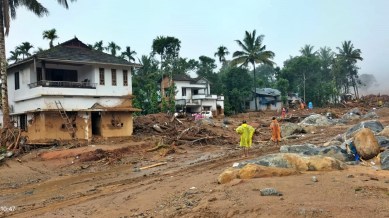Forefathers made Wayanad their home, now dreams lie buried here
Almost everyone in Mundakkai, Chooralmala and other parts of the landslide-hit Wayanad hills trace their ancestry to people who were brought by the British from various parts of South India to work on the plantations.

Ashraf hasn’t known a life beyond the hills of Wayanad. He first came to Mundakkai village as a four-year-old, accompanying his parents who had moved from Nilambur in Malappuram district to work on the tea plantations. Like his parents before him, he found a job on the tea estates when he turned 22. But unlike them, he allowed himself to dream of a better life for himself and his four children.
“I have always lived in the estate quarters – first with my parents and later, my wife and children. But I always dreamt of owning a piece of land. I recently bought 10 cents (around 4,355 sq ft), hoping I will some day build my own house,” he says.
But the landslide of July 30, which tore through the hills of Wayanad, has washed away his dreams, ravaging Mundakkai and Chooralmala, two of the worst-affected villages. “Now it’s all over. The landslide has rendered my land useless. That plot will have to be abandoned. Nobody will buy it either,” he says.
Ashraf had been staying with a relative in Kalpetta town for a week since the landslides. On Tuesday, he returned to Mundakkai and saw the quarters he used to live in reduced to rubble.
Almost everyone in Mundakkai, Chooralmala and other parts of the landslide-hit Wayanad hills trace their ancestry to people who were brought by the British from various parts of South India to work on the plantations.
They talk proudly of how their fathers or grandfathers toiled on the land, turning the hills into verdant tea and coffee plantations. Though they stayed in stuffy quarters, they dreamt of a better future for their children.
The second and third generations from among these plantation workers went on to own houses and vehicles and sent their children to schools and colleges in Kerala and beyond. Many of them also went abroad to work, especially to the Gulf, and their remittances brought in a new affluence to the region. In the lower belts of the hillocks, they built new, fancier homes with courtyards and porches for their new cars.
It’s this – the newer structures built through sheer grit and toil – that the gushing waters washed away, while most of the dilapidated worker quarters and the old-fashioned estate bungalows on the upper areas of the hillocks, where their forefathers lived, remained untouched by the landslide.
As the water receded, it left behind mangled remains of cars, jeeps, two-wheelers and house appliances.
At the relief camp, K Annayyan and his wife Shakunthala are unsure of what lies ahead. Annayyan says his parents came to Chooralmala from Udupi in Karnataka as plantation workers. “I don’t remember the year my parents came to Wayanad. I was born here. Chooralmala is the only home I know,” says Annayyan, 67.
After years of toil, Annayyan bought two acres in the coffee plantations and built a house for his family. “My house as well as the entire coffee plantation were lost in the landslide. My son and daughter, both engineers, are married and settled outside Kerala. But how can I depend on my children? This was my home… where else can I go?” he asks.
Over the years, as the plantation sector reeled under losses, village residents hoped to capitalise on the region’s tourism potential, with some setting up resorts and homestays, and others finding allied jobs. Meppadi panchayat has 220 registered SUVs which take tourists up and down the hills.
Suneesh Madhavan, a resident of Chooralmala whose grandfathers migrated to the village from Karnataka, owned a Jeep that he lent to tourists. “Everything is gone. What will happen to those who are living here? The tourists won’t come back… Our schools, hospitals and home are gone forever. Will they ever be rebuilt?” he asks.
“Due to the tourism boom in this region, our land fetched good rates. But now that this is seen as a vulnerable region, the prices will crash. We can no longer mortgage out land for loans for agriculture and education. The future of our children will be affected,” says another resident of Chooralmala.
V Unnikrishan, headmaster at the Government Vocational Higher Secondary School, Vellarmala, says the tragedy struck just when aspirations in the region were growing. “Around two decades ago, tea estate workers sent their children to schools just so that they could be safe and taken care of while they were away in the plantations. Over the years, that attitude has changed and we now have one of the best schools in the district,” says Unnikrishnnan, who has taught in the school for the last 18 years.
He says there is no option but to rebuild. “We want this village back. I don’t think people would want to leave the hills. They have built it with their own hands,” he says.